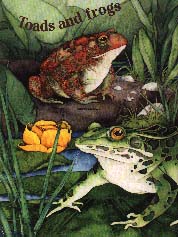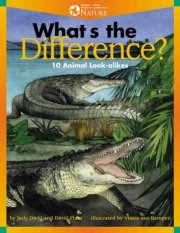|
________________
CM . . . .
Volume VII Number 12 . . . . February 16, 2001
excerpt: If you compare the crocodiles and alligators that are found in North America, you will spot other differences, too. American crocodiles have two bottom teeth that stick out when their mouths are closed. All American crocodiles show the same teeth - the fourth one from the front, on each side. American alligators don't have teeth that stick out when their jaws are shut.  What's the Difference? compares 10 animal look-alikes: leopards and cheetahs; tortoises and
turtles; wasps and bees; crocodiles and alligators; rabbits and hares; toads and frogs; ravens and
crows; butterflies and moths; donkeys and mules; and porpoises and dolphins. As an aged
reviewer, I find books like What's the Difference? very often teach me about new subjects,
which, if I ever had been aware of them, I have since forgotten. Thus I find it difficult to
categorize them for the proper age and grade group. The press release which accompanies this
book states it is for ages 4 to 7. Four-year-old children would need a good deal of adult input to
explain the differences, and most seven-year-old children would have difficulty reading the text.
Consequently, I think a more appropriate audience would be ages 4-11, although even adults
would find it informative, and younger children would enjoy identifying the animals in Judy Diehl's
beautiful paintings, showing the preferred habitat of each pair.
What's the Difference? compares 10 animal look-alikes: leopards and cheetahs; tortoises and
turtles; wasps and bees; crocodiles and alligators; rabbits and hares; toads and frogs; ravens and
crows; butterflies and moths; donkeys and mules; and porpoises and dolphins. As an aged
reviewer, I find books like What's the Difference? very often teach me about new subjects,
which, if I ever had been aware of them, I have since forgotten. Thus I find it difficult to
categorize them for the proper age and grade group. The press release which accompanies this
book states it is for ages 4 to 7. Four-year-old children would need a good deal of adult input to
explain the differences, and most seven-year-old children would have difficulty reading the text.
Consequently, I think a more appropriate audience would be ages 4-11, although even adults
would find it informative, and younger children would enjoy identifying the animals in Judy Diehl's
beautiful paintings, showing the preferred habitat of each pair.
In the "excerpt" above, the text gives an example in the last paragraph of exceptions to the rules which make identification of differences confusing. Perhaps it might have been better to omit phrases like "But don't expect. . .," or, as in the description of dolphins and porpoises living together--"to tell a dolphin from a porpoise in those places, you must ask a whale expert for help." Recommended with Reservations. Joan Payzant is a former teacher-librarian who lives in Dartmouth, NS.
To comment on this title or this review, send mail to cm@umanitoba.ca.
Copyright © the Manitoba Library Association.
Reproduction for personal use is permitted only if this copyright notice
is maintained. Any other reproduction is prohibited without
permission.
Published by
TABLE OF CONTENTS FOR THIS ISSUE - February 16, 2001.
AUTHORS |
TITLES |
MEDIA REVIEWS |
PROFILES |
BACK ISSUES |
SEARCH |
ORDER |
CMARCHIVE |
HOME
|
